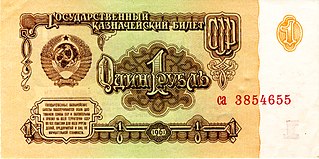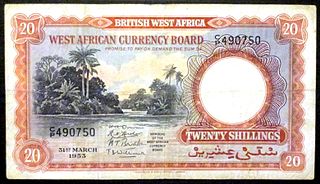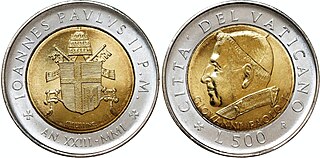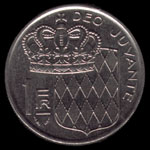
The markka was the currency of Finland from 1860 until 28 February 2002, when it ceased to be legal tender. The markka was divided into 100 pennies, abbreviated as "p". At the point of conversion, the rate was fixed at €1 = 5.94573 Mk.

The peseta was the currency of Spain between 1868 and 2002. Along with the French franc, it was also a de facto currency used in Andorra.
Cupronickel or copper-nickel (CuNi) is an alloy of copper that contains nickel and strengthening elements, such as iron and manganese. The copper content typically varies from 60 to 90 percent.

The East German mark, commonly called the eastern mark in West Germany and after reunification), in East Germany only Mark, was the currency of the German Democratic Republic. Its ISO 4217 currency code was DDM. The currency was known officially as the Deutsche Mark from 1948 to 1964, Mark der Deutschen Notenbank from 1964 to 1967, and from 1968 to 1990 as the Mark der DDR. The mark (M) was divided into 100 Pfennig (pf).

The franc, also commonly distinguished as the French franc (FF), was a currency of France. Between 1360 and 1641, it was the name of coins worth 1 livre tournois and it remained in common parlance as a term for this amount of money. It was reintroduced in 1795. After two centuries of inflation, it was redenominated in 1960, with each new franc (NF) being worth 100 old francs. The NF designation was continued for a few years before the currency returned to being simply the franc. Many French residents, though, continued to quote prices of especially expensive items in terms of the old franc, up to and even after the introduction of the euro in 2002. The French franc was a commonly held international reserve currency of reference in the 19th and 20th centuries. Between 1998 and 2002, the conversion of francs to euros was carried out at a rate of 6.55957 francs to 1 euro.

Exonumia are numismatic items other than coins and paper money. This includes "Good For" tokens, badges, counterstamped coins, elongated coins, encased coins, souvenir medallions, tags, wooden nickels and other similar items. It is an aspect of numismatics and many coin collectors are also exonumists.

A debasement of coinage is the practice of lowering the intrinsic value of coins, especially when used in connection with commodity money, such as gold or silver coins. A coin is said to be debased if the quantity of gold, silver, copper or nickel in the coin is reduced.

The lira was the currency of Italy between 1861 and 2002. It was introduced by the Napoleonic Kingdom of Italy in 1807 at par with the French franc, and was subsequently adopted by the different states that would eventually form the Kingdom of Italy in 1861. It was subdivided into 100 centesimi, which means "hundredths" or "cents". The lira was also the currency of the Albanian Kingdom from 1941 to 1943.
The Congolese franc is the currency of the Democratic Republic of the Congo. It is subdivided into 100 centimes. However, centimes no longer have a practical value and are no longer used. In April 2022, 2,000 francs was equivalent to US$1.

The Egyptian pound is the official currency of Egypt. It is divided into 100 piastres, or ersh, or 1,000 milliemes.

The dinar is the national currency of Tunisia. It is subdivided into 1000 milim or millimes (ملّيم). The abbreviation DT is often used in Tunisia, although writing "dinar" after the amount is also acceptable ; the abbreviation TD is also mentioned in a few places, but is less frequently used, given the common use of the French language in Tunisia, and the French derivation of DT.

The Belgian franc was the currency of the Kingdom of Belgium from 1832 until 2002 when the Euro was introduced. It was subdivided into 100 subunits, each known as a centiem in Dutch, centime in French or a Centime in German.

The ruble or rouble was the currency of the Soviet Union. It was introduced in 1922 and replaced the Imperial Russian ruble. One ruble was divided into 100 kopecks. Soviet banknotes and coins were produced by the Federal State Unitary Enterprise in Moscow and Leningrad.

The Rwandan franc is the currency of Rwanda. It is subdivided into 100 centimes.
The franc is the official currency of Comoros. It is nominally subdivided into 100 centimes, although no centime denominations have ever been issued.

The history of Chinese currency spans more than 3000 years. Currency of some type has been used in China since the Neolithic age which can be traced back to between 3000 and 4500 years ago. Cowry shells are believed to have been the earliest form of currency used in Central China, and were used during the Neolithic period.

The pound was the currency of British West Africa, a group of British colonies, protectorates and mandate territories. It was equal to one pound sterling and was similarly subdivided into 20 shillings, each of 12 pence.

The lira was the currency of the Vatican City between 1929 and 2002. It was not a separate currency but an issue of the Italian lira; the Banca d'Italia produced coins specifically for Vatican City.

The piastre de commerce was the currency of French Indochina between 1885 and 1952. It was subdivided into 100 cents, each of 2~6 sapèques.

The franc was the official currency of the Principality of Monaco until 1995, when it changed to the French franc which was replaced by the euro in 2002. The franc was subdivided into 100 centimes or 10 décimes. The Monégasque franc circulated alongside the French franc with the same value. Like the French franc, the Monégasque franc was revalued in 1960 at a rate of 100 old francs = 1 new franc. The official euro-to-franc exchange rate was MCF 6.55957 to EUR 1.

























